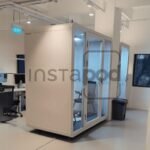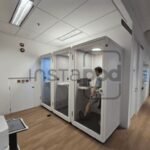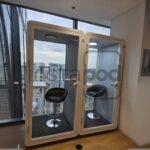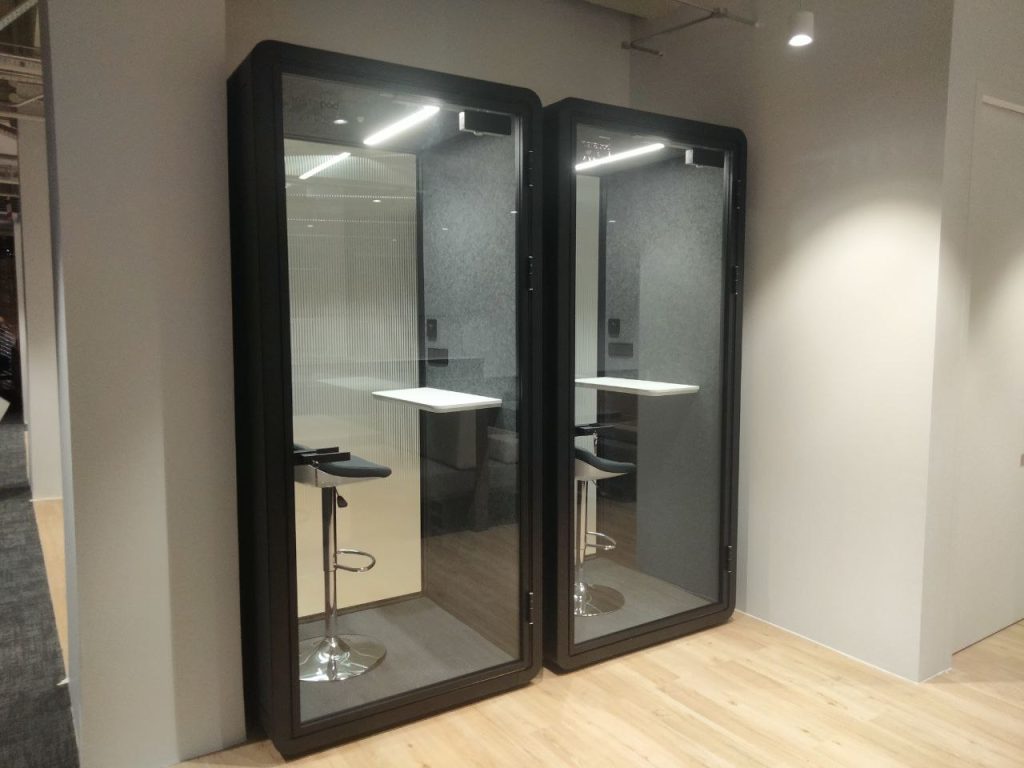No pods added to your quote request yet. Add some now for a free quote!
Designing the Ultimate Workspace: How Office Pods Fit In

In today’s rapidly evolving work environment, the concept of the traditional office is undergoing a significant transformation. The once-standard open floor plan, with its rows of desks and communal spaces, is being reimagined to better accommodate the diverse needs of a modern workforce. Central to this evolution is the growing trend of office pods—small, enclosed spaces designed for privacy and focused work. But how do these pods fit into the ultimate workspace design? Let’s explore their role in creating a more effective and versatile office environment.
The Rise of Flexible Workspaces
The shift towards more flexible work environments has been driven by several factors, including the rise of remote work, the need for more personalized workspaces, and a growing understanding of how different tasks require different settings. Employees today expect their workplaces to be adaptable, offering a range of spaces that cater to different activities—whether it’s collaborative brainstorming, quiet concentration, or informal meetings.
Office pods perfectly align with this trend by providing an easily reconfigurable solution. These pods can be moved, added, or removed as the needs of the workspace change, offering a level of flexibility that is difficult to achieve with traditional office layouts.
The Need for Privacy in Open-Plan Offices
One of the most significant criticisms of open-plan offices is the lack of privacy. While these layouts promote collaboration and communication, they can also lead to distractions, noise, and a lack of personal space. Employees who need to focus on tasks that require deep concentration or confidential discussions often struggle in such environments.
Office pods address this issue by offering a private, soundproof space within the larger open-plan office. These enclosed areas provide employees with a place to retreat when they need to concentrate, make a phone call, or have a confidential meeting. By incorporating office pods into the design, companies can offer the best of both worlds—a collaborative open environment with designated areas for privacy.
Enhancing Productivity and Well-being
The design of a workspace has a direct impact on employee productivity and well-being. A well-designed office can enhance focus, reduce stress, and even improve employee satisfaction and retention. Office pods contribute to these outcomes by providing a comfortable, quiet space that is free from the usual distractions of an open office.
In addition to offering a space for focused work, many office pods are designed with ergonomics and comfort in mind. They often include features such as adjustable lighting, ventilation, and comfortable seating, which can help reduce the physical strain that comes with long periods of desk work. By providing a space that is both comfortable and functional, office pods can help employees stay productive and engaged throughout the day.
Fostering Innovation and Creativity
Innovation and creativity thrive in environments that encourage both collaboration and individual thought. While open spaces are great for spontaneous discussions and team brainstorming sessions, they can sometimes stifle the deep thinking and reflection that lead to breakthrough ideas.
Office pods offer a solution by providing a space where employees can step away from the hustle and bustle of the office and think creatively in a quiet, focused environment. These pods can be used for activities such as writing, designing, or problem-solving—tasks that require uninterrupted time and focus. By integrating office pods into the workspace, companies can create an environment that fosters both collaborative and independent work, ultimately driving innovation and creativity.
Adapting to the Post-Pandemic Workplace
The COVID-19 pandemic has accelerated many of the trends that were already shaping the future of work, including the demand for more flexible and adaptable office spaces. As companies rethink their office layouts to accommodate hybrid work models, social distancing, and health and safety concerns, office pods have emerged as a valuable tool in this transition.
Office pods can be easily spaced out to comply with social distancing guidelines and can be sanitized between uses, making them a practical option for maintaining a safe and healthy work environment. Additionally, as employees return to the office after months of remote work, they may have a greater need for privacy and quiet spaces to readjust to the office setting. Office pods can help ease this transition by providing a familiar, enclosed space where employees can work comfortably and securely.
Conclusion
Incorporating office pods into the design of a workspace is an effective way to address the diverse needs of today’s workforce. These versatile, adaptable spaces offer a solution to many of the challenges associated with open-plan offices, from noise and distractions to the need for privacy and focused work. By integrating office pods into the overall design, companies can create a more dynamic, productive, and employee-friendly work environment that supports both collaboration and individual work. As the workplace continues to evolve, office pods are likely to play an increasingly important role in designing the ultimate workspace.
Check these out too!
-
 Can Telephone Booth Replace a Private Office?December 5, 2025/0 Comments
Can Telephone Booth Replace a Private Office?December 5, 2025/0 Comments -
 Soundproof Pod: The Quiet Revolution in Workplace DesignDecember 5, 2025/
Soundproof Pod: The Quiet Revolution in Workplace DesignDecember 5, 2025/ -
 How Acoustic Pods Improve Collaboration & FocusDecember 5, 2025/
How Acoustic Pods Improve Collaboration & FocusDecember 5, 2025/

